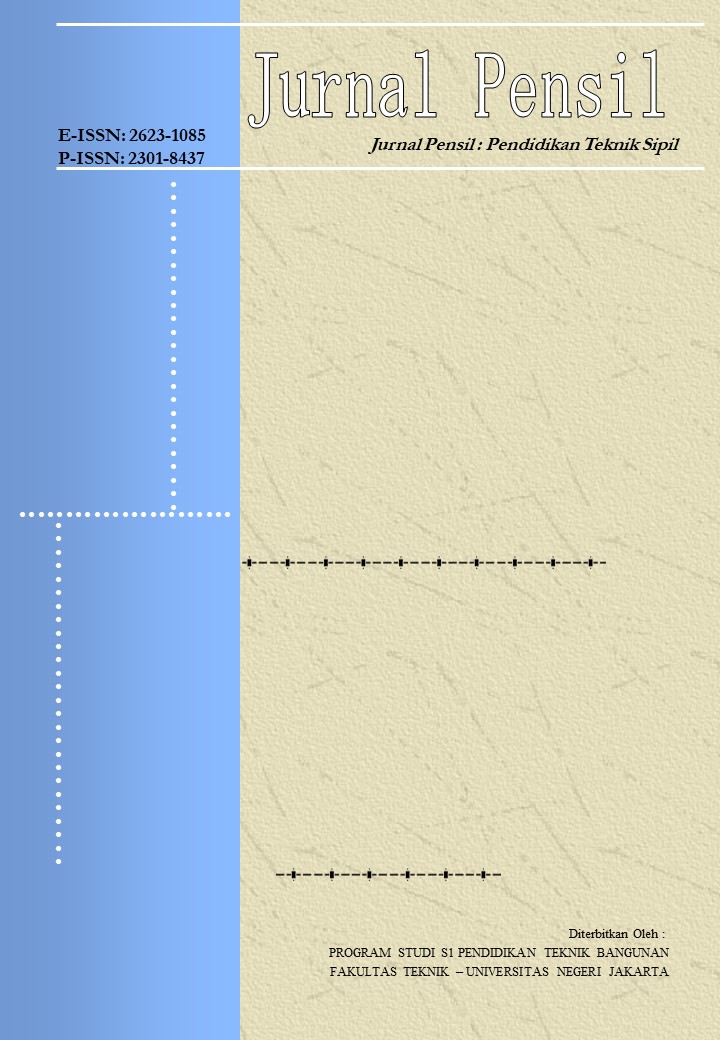DEVELOPMENT OF WORK BREAKDOWN STRUCTURE USING BUILDING INFORMATION MODELING AT UNJ
Abstract
Building maintenance must also be carried out on campus buildings, because every day they are used by the academic community in their activities in large numbers. For that we need buildings that are safe, comfortable, and decent. Building maintenance in Indonesia is regulated in the Regulation of the Minister of Public Works No.24/PRT/M/2008 concerning Building Maintenance. This arrangement was updated with the passing of Law number 11 of 2020 concerning Job Creation. Based on this, it is also necessary to know the best building maintenance methods that must be applied based on the right approach. This study aims to plan a maintenance method for the L5 building on the UNJ Campus based on the Work Breakdown Structure (WBS) using Building Information Modeling (BIM). Based on a series of studies on the UNJ Campus L5 building that is integrated with BIM, it will improve the process of maintaining and repairing buildings. The results of this early stage research are expected to provide an overview and recommendations on how to maintain the UNJ Campus building.
References
Acampa, G., Diana, L., Marino, G., & Marmo, R. (2021a). Assessing the transformability of public housing through bim. Sustainability (Switzerland), 13(10). https://doi.org/10.3390/su13105431
Acampa, G., Diana, L., Marino, G., & Marmo, R. (2021b). Assessing the transformability of public housing through bim. Sustainability (Switzerland), 13(10). https://doi.org/10.3390/su13105431
Al-Kasasbeh, M., Abudayyeh, O., & Liu, H. (2021a). An integrated decision support system for building asset management based on BIM and Work Breakdown Structure. Journal of Building Engineering, 34, 101959. https://doi.org/https://doi.org/10.1016/j.jobe.2020.101959
Al-Kasasbeh, M., Abudayyeh, O., & Liu, H. (2021b). An integrated decision support system for building asset management based on BIM and Work Breakdown Structure. Journal of Building Engineering, 34. https://doi.org/10.1016/j.jobe.2020.101959
Azhar, S., Khalfan, M., & Maqsood, T. (2015). Building information modelling (BIM): now and beyond. Construction Economics and Building, 12(4), 15–28. https://doi.org/10.5130/AJCEB.v12i4.3032
Bucoń, R., & Czarnigowska, A. (2021). A model to support long-term building maintenance planning for multifamily housing. Journal of Building Engineering, 44. https://doi.org/10.1016/j.jobe.2021.103000
Charef, R. (2022). The use of Building Information Modelling in the circular economy context: Several models and a new dimension of BIM (8D). Cleaner Engineering and Technology, 7. https://doi.org/10.1016/j.clet.2022.100414
D’Orazio, M., Di Giuseppe, E., & Bernardini, G. (2022). Occupant density impact on building maintenance: Data-driven approach for university buildings. Automation in Construction, 141, 104451. https://doi.org/10.1016/j.autcon.2022.104451
Ensafi, M., Harode, A., & Thabet, W. (2022). Developing systems-centric as-built BIMs to support facility emergency management: A case study approach. Automation in Construction, 133. https://doi.org/10.1016/j.autcon.2021.104003
Flores-Colen, I., & de Brito, J. (2010). A systematic approach for maintenance budgeting of buildings façades based on predictive and preventive strategies. Construction and Building Materials, 24(9), 1718–1729. https://doi.org/10.1016/j.conbuildmat.2010.02.017
Fournier, E. D., Federico, F., Cudd, R., & Pincetl, S. (2023). Building an interactive web mapping tool to support distributed energy resource planning using public participation GIS. Applied Geography, 152, 102877. https://doi.org/https://doi.org/10.1016/j.apgeog.2023.102877
Fu, F. (2018). Design and Analysis of Tall and Complex Structures. In Design and Analysis of Tall and Complex Structures. Elsevier. https://doi.org/10.1016/c2015-0-06071-3
Gao, X., & Pishdad-Bozorgi, P. (2019). BIM-enabled facilities operation and maintenance: A review. In Advanced Engineering Informatics (Vol. 39, pp. 227–247). Elsevier Ltd. https://doi.org/10.1016/j.aei.2019.01.005
Geng, Y., Ji, W., Wang, Z., Lin, B., & Zhu, Y. (2019). A review of operating performance in green buildings: Energy use, indoor environmental quality and occupant satisfaction. Energy and Buildings, 183, 500–514. https://doi.org/10.1016/j.enbuild.2018.11.017
Gouda Mohamed, A., Abdallah, M. R., & Marzouk, M. (2020). BIM and semantic web-based maintenance information for existing buildings. Automation in Construction, 116. https://doi.org/10.1016/j.autcon.2020.103209
Handayaniputri, A., Sagita Riantini, L., Latief, Y., & Dwiantoro, D. (2019). Development of E-Maintenance in Green Building Maintenance and Repair Work of Government Buildings Based on Work Breakdown Structure Using Building Information Modeling. In International Journal of Engineering Research and Technology (Vol. 12). http://www.irphouse.com
Hosseini, O., & Maghrebi, M. (2021). Risk of fire emergency evacuation in complex construction sites: Integration of 4D-BIM, social force modeling, and fire quantitative risk assessment. Advanced Engineering Informatics, 50. https://doi.org/10.1016/j.aei.2021.101378
Huang, Z., Lu, Y., Wong, N. H., & Poh, C. H. (2019). The true cost of “greening” a building: Life cycle cost analysis of vertical greenery systems (VGS) in tropical climate. Journal of Cleaner Production, 228, 437–454. https://doi.org/10.1016/j.jclepro.2019.04.275
Huo, X., Yu, A. T. W., Darko, A., & Wu, Z. (2019). Critical factors in site planning and design of green buildings: A case of China. Journal of Cleaner Production, 222, 685–694. https://doi.org/10.1016/j.jclepro.2019.03.123
Ismail, Z. A. (2021). How BIM systems affect maintaining IBS building. Facilities, 39(3–4), 196–214. https://doi.org/10.1108/F-08-2019-0082
Kenley, R., & Harfield, T. (2014). Reviewing the IJPM for WBS: The Search for Planning and Control. Procedia - Social and Behavioral Sciences, 119, 887–893. https://doi.org/10.1016/j.sbspro.2014.03.099
Kim, G., Lim, H. S., Lim, T. S., Schaefer, L., & Kim, J. T. (2012). Comparative advantage of an exterior shading device in thermal performance for residential buildings. Energy and Buildings, 46, 105–111. https://doi.org/10.1016/j.enbuild.2011.10.040
Kwong, Q. J. (2020). Light level, visual comfort and lighting energy savings potential in a green-certified high-rise building. Journal of Building Engineering, 29(October 2019), 101198. https://doi.org/10.1016/j.jobe.2020.101198
Li, C. Z., Guo, Z., Su, D., Xiao, B., & Tam, V. W. Y. (2022). The Application of Advanced Information Technologies in Civil Infrastructure Construction and Maintenance. In Sustainability (Switzerland) (Vol. 14, Issue 13). MDPI. https://doi.org/10.3390/su14137761
Li, Q., Long, R., Chen, H., Chen, F., & Wang, J. (2020). Visualized analysis of global green buildings: Development, barriers and future directions. Journal of Cleaner Production, 245. https://doi.org/10.1016/j.jclepro.2019.118775
Li, Y., & Zhang, X. (2013). Web-based construction waste estimation system for building construction projects. Automation in Construction, 35, 142–156. https://doi.org/https://doi.org/10.1016/j.autcon.2013.05.002
Loeh, R., Everett, J. W., Riddell, W. T., & Cleary, D. B. (2021). Enhancing a Building Information Model for an Existing Building with Data from a Sustainable Facility Management Database. Sustainability, 13(13), 7014. https://doi.org/10.3390/su13137014
Marenjak, S. (2012). Analysis of buildings operation and maintenance costs. Journal of the Croatian Association of Civil Engineers, 64(4), 293–303. https://doi.org/10.14256/jce.651.2011
Marmo, R., Polverino, F., Nicolella, M., & Tibaut, A. (2020). Building performance and maintenance information model based on IFC schema. Automation in Construction, 118. https://doi.org/10.1016/j.autcon.2020.103275
Masood, O. A. I., Al-Hady, M. I. A., & Ali, A. K. M. (2017). Applying the Principles of Green Architecture for Saving Energy in Buildings. Energy Procedia, 115, 369–382. https://doi.org/10.1016/j.egypro.2017.05.034
Matos, R., Rodrigues, F., Rodrigues, H., & Costa, A. (2021). Building condition assessment supported by Building Information Modelling. Journal of Building Engineering, 38, 102186. https://doi.org/10.1016/j.jobe.2021.102186
Mejía, K. J., Barbero-Barrera, M. D. M., & Pérez, M. R. (2020). Evaluation of the impact of the envelope system on thermal energy demand in hospital buildings. Buildings, 10(12), 1–17. https://doi.org/10.3390/buildings10120250
Morgado, F. F. R., Meireles, J. F. F., Neves, C. M., Amaral, A. C. S., & Ferreira, M. E. C. (2017). Scale development: Ten main limitations and recommendations to improve future research practices. Psicologia: Reflexao e Critica, 30(1), 1–20. https://doi.org/10.1186/s41155-016-0057-1
Mydin, A. O. (2015). SIGNIFICANCE OF BUILDING MAINTENANCE MANAGEMENT SYSTEM TOWARDS SUSTAINABLE DEVELOPMENT: A REVIEW. In Journal of Engineering Studies and Research (Vol. 21, Issue 1).
Nasir, T. (2014). Performance of Building Maintenance in Operation & Management at Commercial Building.
Omar, N. S., Hatem, W. A., & Najy, H. I. (2018). Developing of building maintenance management by using bim. International Journal of Civil Engineering and Technology, 9, 1371–1383.
Park, J., & Cai, H. (2017). WBS-based dynamic multi-dimensional BIM database for total construction as-built documentation. Automation in Construction, 77, 15–23. https://doi.org/https://doi.org/10.1016/j.autcon.2017.01.021
Pishdad-Bozorgi, P., Gao, X., Eastman, C., & Self, A. P. (2018). Planning and developing facility management-enabled building information model (FM-enabled BIM). Automation in Construction, 87, 22–38. https://doi.org/10.1016/j.autcon.2017.12.004
Uddin, M. N., Wang, Q., Wei, H. H., Chi, H. L., & Ni, M. (2021). Building information modeling (BIM), System dynamics (SD), and Agent-based modeling (ABM): Towards an integrated approach. Ain Shams Engineering Journal, 12(4), 4261–4274. https://doi.org/10.1016/j.asej.2021.04.015
Weerasinghe, A. S., & Ramachandra, T. (2018). Economic sustainability of green buildings: a comparative analysis of green vs non-green. Built Environment Project and Asset Management, 8(5), 528–543. https://doi.org/10.1108/BEPAM-10-2017-0105
Copyright (c) 2023 Rezi Berliana Yasinta, Adhi Purnomo, Alwan Izzudin

This work is licensed under a Creative Commons Attribution-ShareAlike 4.0 International License.



.jpg)








.png)
.png)
1.png)

